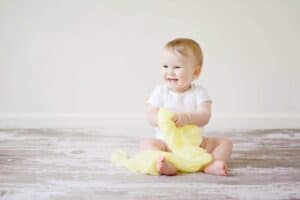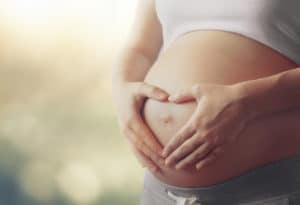Baby’s health is especially important to mothers and fathers. Bronchitis in babies is generally much more common than bronchitis in grown-ups. Bronchitis symptoms in newborns and small children are usually rather harmless compared to bronchitis in adults.
In addition, they usually subside after a few days. However, you should have your pediatrician check what type of bronchitis it is. In the case of bronchiolitis and obstructive bronchitis, you should be careful and always follow the advice of an experienced specialist.
Table of contents
Bronchitis In Babies: The Typical Symptoms
One of the typical bronchitis symptoms is dry cough, which tends to become mucous over time. In addition, the dear little ones feel pain or a certain pressure in the bronchial tubes.
All this is very unpleasant for them, so they sometimes suffer from problems falling asleep because of it. They are crotchety and restless during the day. Accordingly, parents also feel burdened by it.
Different Types Of Bronchitis
When the bronchial area is inflamed, it is called bronchitis. The so-called acute bronchitis disease is characterized by the fact that the sensitive mucous membranes in the bronchial muscles are reddened and inflamed due to a viral infection.
It is not only the dry cough that troubles children, but also the mucus production that occurs later. In addition, rhinitis occurs, which can usually be accompanied by a slightly elevated body temperature.
In the summer season, bronchitis in babies occurs less frequently. In autumn and winter, however, there is a much greater risk of the bronchial tubes becoming chilled or inflamed.
This is because the child’s immune system is simply not yet fully developed. Therefore, babies are comparatively more likely to get bronchitis than adults. What you should also know about bronchitis in babies and what you can do about it – that’s what you’ll learn in this article.
Bronchitis In Babies – What You Should Know
The respiratory tract and especially the immune system are not yet fully developed in infancy. This can be associated with an increased risk of illness or infection. For this reason, bronchitis can occur comparatively frequently in children during the first three years of life.
Adults also occasionally have to deal with bronchitis. However, there are a number of things to bear in mind with regard to the clinical picture. The course of the disease in children and adults is not identical in every respect.
Pronounced Bronchitis Symptoms In Babies
Bronchitis is an inflammation of the mucous membranes in the lower and upper respiratory tract. Children usually experience a much higher degree of suffering than adults. In addition, you should know that the risk of possible complications is also significantly higher in babies than in adults.
It all usually starts with a dry cough. The longer this phase lasts, the more painful the course of the disease. This painful sensation results from the fact that the dry cough successively irritates the throat or mucous membranes.
In addition, there is shortness of breath and a slight fever. Heavy breathing also has a stressful effect on the sensitive bronchial area of the child and additionally weakens the baby. In this respect, the baby reacts tiredly during the day but still finds it difficult to fall asleep. He cries a lot and feels unwell.
In the further course of the disease, mucus formation in the bronchial tubes sets in, so that the cough becomes mucous or slightly purulent. Then, at the latest, you will also hear the typical rattling noises from your little treasure, which are often associated with the wet cough.
No Comparison With A Flu-like Infection
When babies suffer from a cold or flu infection, the cough is usually perceived as particularly annoying. In addition, they have to deal with a blocked nose, sore throat, cough, and possibly nausea and vomiting.
Also, sick babies are often additionally diagnosed with conjunctivitis. However, all these are symptoms that do not occur with bronchitis in the baby. However, it often happens that acute bronchitis in the baby occurs in conjunction with whooping cough, rubella or measles.
Bronchitis In Babies: This Special Form Exists
Obstructive or spastic bronchitis is characterized by narrowed airways. Spastic bronchitis occurs relatively frequently, especially in children during the first 36 months of life.
The reason for this is that the bronchi are still relatively small and soft. They are not yet fully developed, so the bronchial muscles can spasm much more quickly. In addition, the mucus production associated with bronchitis in the baby is an additional burden.
Loud Bronchitis Symptoms
Breathing is much more difficult for infants than adults suffering from bronchitis. The rattling sound when coughing as well as the soft whistling from the throat – this is called gieving – are further symptoms of spastic bronchitis.
Not only because these sounds sound very dangerous, you should definitely go to the doctor with your child. It is important that he is now given medications that will strengthen the activity of his immune system and support the healing process as a whole.
Spastic Bronchitis And Its Consequences
The mucus has a detrimental effect on the condition or function of the airways. The fine airway ramifications are successively weakened. In the worst case, this may even cause them to collapse when you take a breath due to the negative pressure created in this area.
As a consequence, the gas exchange in the lungs of the diseased child is considerably impaired.
As a rule, the chances of recovery are very good if chronic bronchitis is present. The older your child gets, the lower the risk of a recurrence of bronchitis.
Tip:
In addition to the loud noises that are often noticeable in small bronchitis patients, the gag reflex and bloody sputum are also symptoms that frighten mothers and fathers alike.
However, medical experts give the all-clear in this regard. Babies and toddlers are certainly capable of coughing up the mucus that has formed. But when it comes to coughing up or spitting out the mucus, they have a hard time. As a result, babies swallow the mucus. This is another trigger for breathing difficulties.
Often, severe coughing attacks occur a short time later. In this case, the swallowed mucus remnants can be transported upward together with some of the stomach contents. This then appears as if the child has vomited.
The impression of bloody sputum, on the other hand, is rather due to the slight tears or injuries on the mucous membranes. Due to the previous dry cough, these are extremely stressed and irritated. Due to the tiny injuries, you may notice bloody traces in the mucus.
Bloody Bronchitis Symptoms
Do you also notice the bloody mucus secretions in your baby’s nasopharynx? Or do they rather come from the lower respiratory tract? Doctors believe that the tiny traces of blood are harmless in both cases.
Therefore, mothers and fathers do not need to worry about them. However, if you are not quite sure because you may notice larger amounts of blood in your baby’s mucus remnants, then a visit to the doctor is inevitable.
While bronchitis in babies often clears up after 8 to 14 days, the cough can sometimes persist. If the bronchitis symptoms reappear after some time and the cough is still noticeable, it could be that your child has chronic bronchitis. Be sure to clarify this issue with your pediatrician.
It Is Important That The Doctor Takes Time For The Examination
After a thorough examination, the can not only make a target-oriented diagnosis and recommend appropriate forms of treatment. In addition, the focus is also on strengthening the immune system. This is the only way to combat viruses and pathogens in the long term.
Good To Know
If chronic bronchitis or spastic bronchitis is not treated in time or adequately, it could spread and progress to constrictive bronchitis. It is equally important that you give your sweetheart the opportunity to let the bronchitis subside in peace.
It should therefore sleep longer in the morning or be put to bed earlier in the evening. After all, sleep is the best medicine, as the old saying goes.
The procedure of a bronchial examination at the pediatrician:
- First, there is a detailed discussion with the mother or father, so that the physician can learn more about the bronchitis symptoms.
- The lungs or bronchial tubes are listened to with a stethoscope.
- If rales or whistling breath can be heard, this is often an indication of bronchitis in the baby.
- In most cases, the bronchial tubes are x-rayed to find out if obstructive bronchitis is present, if so.
Important
Experience has shown that it is comparatively difficult to diagnose chronic bronchitis. Therefore, additional examinations are often necessary, such as an allergy test.
In addition, the doctor sometimes performs a bronchoscopy. This is a mirror examination of the airways to find out what the triggers for bronchitis in the baby may be.
Treatment Of Bronchitis In Babies
The earlier bronchitis in a baby is treated, the better the chances of recovery. It also reduces the risk of possible secondary diseases or complications. If after two weeks there is still no relief of the bronchitis symptoms in sight, the disease can become chronic bronchitis. You should therefore ask your pediatrician for advice as soon as you notice the first symptoms.
Usually, the pediatrician prescribes mucolytic and cough-relieving medications for bronchitis in babies. It also makes sense to take an anti-inflammatory preparation. If chronic bronchitis is already present, often only an antibiotic will help.
Home Remedies For The Treatment Of Bronchitis In Babies
Honey can relieve cough. The anti-inflammatory and slightly disinfecting effect of the “natural gold” is extremely beneficial and can help eliminate bacteria in the sensitive throat area. Also a homemade decoction of onions and honey – applied externally – is a classic home remedy, of which even the grandmother made use.
It is important that your child drinks plenty of fluids. This makes it easier to loosen the mucus so that it can drain away better. Thus, the sometimes painful cough symptoms will soon be a thing of the past.
Make sure that you take your little treasure out into the fresh air often. Heating air and air-conditioned rooms can be an additional burden for a baby with bronchitis. Of course, you should also focus on the fact that your child is in a room where people smoke.
Conclusion
Many parents get very worried when the sometimes serious bronchitis symptoms appear. However, the rattling and whistling noises as well as the bloody sputum are usually quite harmless. In case of doubt, however, you are well advised to have your baby examined by a pediatrician.
This way you are always on the safe side. It is also important to allow the little rascal to rest and sleep. Try to create a relaxed atmosphere at home so that your baby can relax and fall asleep more easily. Experience has shown that this method promotes the healing process immensely.











4 thoughts on “Bronchitis In Baby: Symptoms, Causes And Treatment”